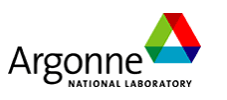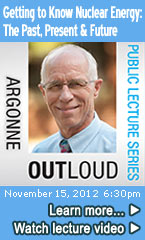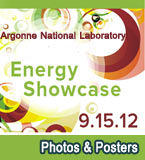Software
MC2-2 (Fast Reactor Cross Section Processing Codes)
|
|
Standard Code Description
- Name and Title of Program:
MC22: A code to calculate fast neutron spectra and multigroup cross sections. - Computer for Which Program is Designed and Other Machine Version Packages Available:
IBM 370/195, IBM 3033, CDC 7600, RS6000, SUN. - Description of Problem or Function:
MC22 solves the neutron slowing-down equations using basic neutron data derived from ENDF/B data files to determine fundamental mode spectra for use in generating multigroup neutron cross sections. The current edition includes the ability to treat all ENDF/B-V and -VI data representations. It accommodates high-order P scattering representations and provides numerous capabilities such as isotope mixing, delayed neutron processing, free-format input, and flexibility in output data selection. - Method of Solution:
The extended transport P1, B1, consistent P1, and consistent B1 fundamental mode ultra-fine-group equations are solved using continuous slowing-down theory and multigroup methods. Fast and accurate resonance integral methods are used in the narrow resonance resolved and unresolved resonance treatments. A fundamental mode homogeneous unit cell calculation is performed using either a multigroup or a continuous slowing-down treatment. Multigroup neutron homogeneous cross sections are generated in an ISOTXS format for an arbitrary group structure. A hyper-fine-group integral transport slowing down calculation (RABANL) is available as an option. RABANL performs a homogeneous or heterogeneous (pin or slab) unit cell calculation over the resonance region (resolved and unresolved) and generates multigroup neutron cross sections in an ISOTXS format. Neutron cross sections are generated by RABANL for the homogeneous unit cell and for each heterogeneous region in the pin or slab unit cell calculation. - Restrictions on the Complexity of the Problems:
The program uses variable dimensioning throughout so that computer storage requirements depend on a variety of problem parameters. Space requirements are approximately 2000 K bytes on RS6000 or SUN equipment depending on the complexity of the problem. - Typical Running Time:
A 1740-group consistent P1 homogeneous twelve-isotope problem with 27 broad groups requires about 6.5 minutes of CPU time on an IBM 370/195. The same problem requires approximately 30% less time on the CDC 7600 and approximately 50% less time on the RS6000 and the SS20 SUN systems. - Unusual Features of the Program:
Extreme flexibility is provided in specifying the rigor of a calculation including a choice of four distinct slowing-down treatments: multigroup, improved and standard Greuling-Goertzel continuous slowing-down, and integral transport theory. All binary data transfers are localized in CCCC standard subroutines REED/RITE. Broad group cross-section files may be generated in the ARC System XS.ISO (Ref. 3) and CCCC ISOTXS (Ref. 4) formats. - Related and Auxiliary Programs:
This edition supersedes previous releases of the MC22 program and the earlier MC2 program. Improved physics algorithms and increased computational efficiency are incorporated. Input data files required by MC22 may be generated from ENDF/B data by the code ETOE-2. The hyper-fine-group integral transport theory module of MC22, RABANL, is an improved version of the RABBLE/RABID codes. Many of the MC22 modules are used in the SDX code. - Status:
IBM and CDC7600 versions of the MC22 code are currently available at the Radiation Safety Information Computational Center (RSICC) together with the MC22 libraries processed through ETOE-2 using ENDF/B-V data. SUN and RS6000 versions of the MC22 code are available at Argonne together with the MC22 libraries processed through ETOE-2 using ENDF/B-V and ENDF/B-VI data. The SUN and RS6000 load models of the code have been exported to other UNIX installations such as those at Oak Ridge and Lawrence Livermore National Laboratories. - References:
- L. C. Leal, C. G. Stenberg, and B. R. Chandler, "Completion of the Conversion of the MC22/ SDX Codes from IBM to SUN (#3)," Argonne National Laboratory Internal Memorandum, May 27, 1993.
- H. Henryson, II, B. J. Toppel, C. G. Stenberg, " MC22: A Code to Calculate Fast Neutron Spectra and Multigroup Cross Sections," Argonne-8144, June 1976.
- L. C. Just, H. Henryson, II, A. S. Kennedy, S. D. Sparck, B. J. Toppel, and P. M. Walker, "The System Aspects and Interface Data Sets of the Argonne Reactor Computation (ARC) System," Argonne-7711, April 1971.
- "Standard Interface Files and Procedures for Reactor Physics Codes, Version III," LA-5486-MS, February 1974.
- C. G. Stenberg and H. Henryson, II, "MC22: Edition B, Information on IBM and CDC Implementation, Use of ENDF/B-V Library, and Added Capabilities," Argonne National Laboratory Internal Memorandum, January 13, 1981.
- C. G. Stenberg and A. Lindeman, "The ARC System Cross Section Generation Capabilities, ARC-MC2," Argonne-7722 excerpt pp. 571-576, June 1973.
- Machine Requirements:
On IBM, SUN, and RS6000 computers at least 2000 K of core memory are required. - Programming Languages Used:
FORTRAN-77 is used. The program can be executed entirely in FORTRAN. Optional dynamic memory allocation and timing routines supplied from host machine libraries or code in "C" may be used on UNIX workstations. - Operating System:
No special requirements are made on the operating system. SunOS 4.1.3x and SOLARIS 2.5 (for SPARCStations), AIX 3.2 on the IBM RS6000, the XMP UNICOS operating system segmentation loader (segldr) and the IBM (MVS/JES3) linkage editor overlay facilities may be used. - Other Programming or Operating Information or Restrictions:
The standalone source code contains approximately 96,000 FORTRAN statements and 444 C statements. - Name and Establishment of Author or Contributor:
- H. Henryson, II, B. J. Toppel, and C. G. Stenberg
Nuclear Engineering Division
Argonne National Laboratory
9700 South Cass Avenue
Argonne, Illinois 60439
- H. Henryson, II, B. J. Toppel, and C. G. Stenberg
- Materials Available:
Distribution of this material may be restricted. Electronic UNIX file includes:- Export Memo
- Source Code (FORTRAN and "C")
- Script to create load module from Source Code
- Sample problem input cards
- Script to run sample problem
- Sample problem output
- Sponsor:
U.S. Department of Energy, Office of Nuclear Energy, Science, and Technology.
Last Modified: Tue, September 20, 2011 11:08 AM






